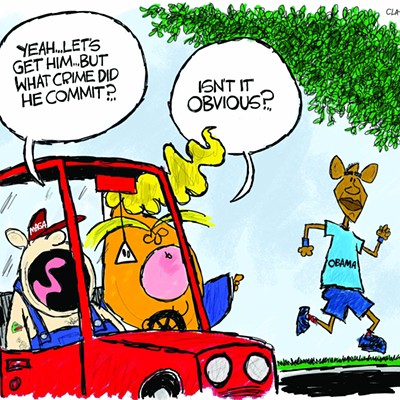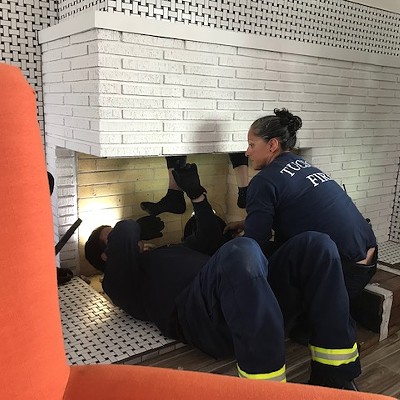Dr. Randall Bennett, head of emergency medicine at St. Joseph's Hospital, spoke with the authority gained through 12 years of medical practice and 27 years as an EMT and paramedic who, until recently, continued to pull shifts with ambulance crews.
His testimony, a centerpiece of the civil-rights lawsuit brought by Johnson's family against the city of Tucson, police officers, fire department paramedics and Southwest Ambulance, came during the third week of trial in U.S. District Court.
Bennett said Johnson suffered an acute asthma attack after police officers Eric Murch and Floyd Ginn chased him from the Circle K, 5501 E. Golf Links Road, to a residence about 160 yards away on Aug. 8, 1999.
Johnson had a history of asthma, a "markedly abnormal respiratory rate" and was exposed to pepper spray, a strong irritant, Bennett said.
Asked by the Johnson family lawyer, Stanton Bloom, if treatment by city paramedics and the Southwest Ambulance crew fell below the community standard, Bennett said yes.
He also said that it was probable that Johnson would have survived had he received proper care.
Bennett would not budge under tough cross-examination by Foster Robberson, the skilled and aggressive lead counsel for Southwest Ambulance. And he refused to buy into Robberson's repeated assertions that Johnson, who had cocaine and opiates in his system, had caused his own death.
Bennett flatly and repeatedly rejected Robberson's notion that Johnson suffered from cocaine toxicity. He similarly rejected Robberson's implication that by giving Johnson oxygen, EMTs would have made him dangerously agitated.
The presence of eosinophils, a type of white blood cell, in Johnson's bronchial walls indicates asthma, Bennett said. Foreign cells found in his lungs were from the pepper spray, he said.
Dr. Cynthia Porterfield, a Pima County forensic pathologist who performed the Johnson autopsy, did not list asthma as a cause of death in her report.
Bennett faulted Tucson Fire paramedics for failing to properly monitor Johnson as he struggled--in the heat, post pepper-spray--for air. His vital signs were taken only once, when Tucson Fire Captain Tim Cornely called for a basic life support ambulance. Southwest Ambulance--a Rural Metro subsidiary--has the contract for basic ambulance service in Tucson.
Johnson, according to four witnesses from the neighborhood, was not threatening and did not seem to pose a risk.
Bennett said that Cornely and his crew should have continued to monitor Johnson. Had they done so, they would have determined that his high respiratory rate was not getting any better. Moreover, Bennett testified, Johnson should not have been face down on the gurney. Bennett explained to the jury how that position--with hands cuffed behind his back--drastically limited his ability to breathe.
The city paramedics also should have provided Johnson with oxygen, Bennett said, and called for an advanced life support ambulance that had a heart monitor and an oxygen bag.
Southwest Ambulance EMT Marcus Werner, Bennett testified, failed to properly monitor Johnson (who was turned on the gurney to face an interior wall), and added that Werner should have kept an eye on Johnson rather than doing paperwork.
And Werner and Amanda Kitchen, who was driving the ambulance, should have gone from Code 2, at normal speed, to Code 3, with lights and siren on, to allow them to drive 60 miles per hour--15 mph faster than the 45 mph limit on Golf Links, Bennett said.
Traffic was not heavy on that Sunday morning. Johnson's heart stopped beating, and he stopped breathing a minute and a half before the ambulance arrived at Kino Community Hospital, a little more than five miles from where Johnson was picked up.
Johnson committed no crime to spur the initial call that morning, but drew the attention of an off-duty cop who, testimony revealed, had put Johnson under surveillance for 150 days. The gas tank of the Cadillac Johnson was driving--not his own--was leaking.
Firefighters were called to clean the spill, and paramedics were called after Johnson was caught while attempting to flee from Murch and Ginn. They wanted to arrest him for having a crack pipe that Ginn said he found on the front seat of the Cadillac.
Ray Thompson, the off-duty cop who made the initial call from the Circle K that morning, provided startling testimony. He acknowledged that he considered Johnson such a bad guy that he had placed him under surveillance for 150 days, ending three weeks before Johnson's fatal encounter with police.
Under questioning by Bloom, Thompson conceded that the surveillance yielded nothing. He also said that he failed to persuade the region's top drug unit, the Metropolitan Area Narcotics Trafficking Interdiction Squads, to target Johnson as a drug dealer.
Thompson was at the Circle K that day, he said, while awaiting a tee-time at the nearby golf course at Davis-Monthan Air Force Base.
Jurors are permitted to submit written questions for each witness, and questions following Thompson's testimony made it clear that Thompson's watch of Johnson had intrigued someone on the 10-member jury. One question asked if there is a law against "stalking" by police, and another asked if Thompson had other things to do and other calls to take while he was parked on Johnson's block.
Testimony in the four-week-old trial is scheduled to conclude April 30.












